Our day trip to the Tower of London was a sponsored visit, thanks to our paid ambassadorship with Historic Royal Palaces (HRP). With access to behind the scenes tours, the Tower’s infamous ravens and a view of the world’s most glittering jewels, our trip was full of surprises, stories and (of course) obligatory gore.
For more information on how to get your own HRP membership, please see here.
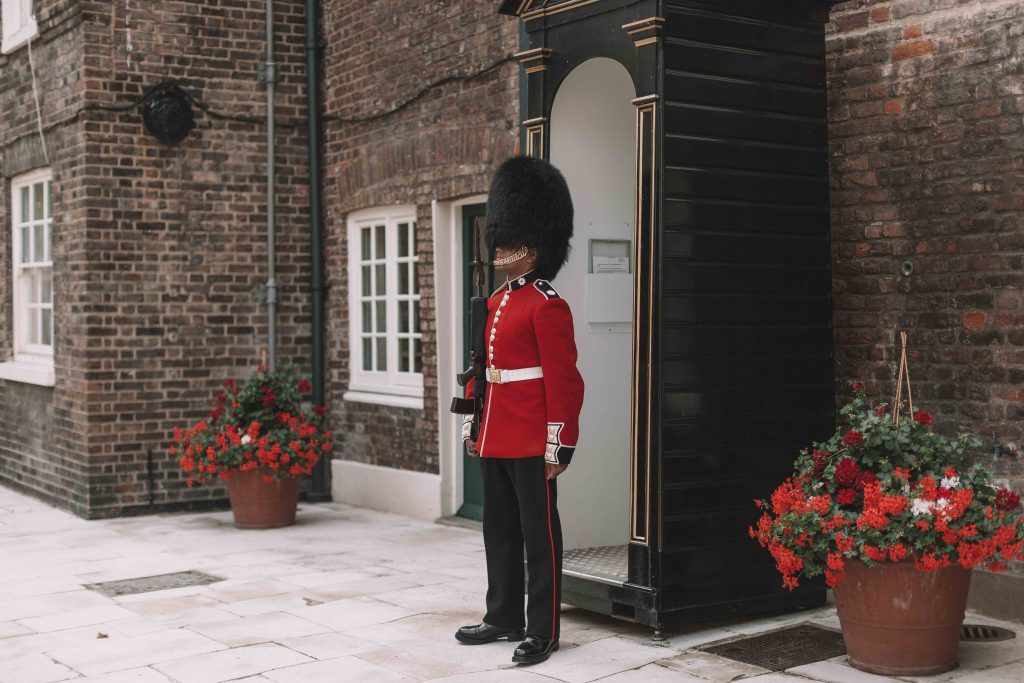
The Tower of London: A Short History
Looming over the soup-like waters of the River Thames, the Tower of London was once the city’s tallest structure. Now dwarfed by the likes of the nearby Shard building, the Tower – the 11th Century vision of William the Conqueror – once punctured London’s skyline; a formidable fortress overlooking Middle Ages England.
Incredibly, the Tower and its wider buildings have changed very little since these early days. In fact (and despite nearly twelve centuries worth of history) the Tower’s moat and high brick walls remain; a vestige to time when London’s population represented a ‘huge and brutal populace’ – something to be protected from.
In its time, the Tower has witnessed an almost impossible amount of history: housing the Royal Mint, an exotic Zoo, prison cells frequented by (to name but a few) Elizabeth I and the Kray Brothers, a luxurious palace and, of course, those mystical oracles – the ravens.
Growing up, it’s the darker and more sinister side of the Tower that I remember. A cold and miserable place, the Tudor ages ensured that the Tower of London became a gory spectacle; a destination filled with rolling heads and quartered limbs. As the dark, cold waters of the Thames lapped at the Tower’s walls and crowds of ravens croaked overhead, the Tower was a place to be avoided.
However, it wasn’t all doom and gloom. During the 13th Century and under the rule of Henry III, the Tower of London and its inner lodgings became a beautiful and opulent Medieval Palace. For over six hundred years, the Tower was also the celebrated home of an exotic menagerie, featuring lions, eagles, leopards, an elephant and – perhaps a little more surreally – a polar bear.
The Tower Today
With its bloody past behind it (the last person to be executed at the Tower was the German spy, Josef Jakobs, in 1941), the Tower of London is now home to something a little more refined: the Crown Jewels. Having been on display at the Tower since 1661, the Jewels are visited by 3 million visitors a year; making the Tower of London one of the country’s most popular tourist destinations.
Declared ‘priceless’ and forbidden from leaving the country, the Jewels are looked after by the Tower’s 37 resident Yeoman Warders – all of whom are required to live on site. Indeed, wander around the Tower’s grounds and you’ll spot family homes, a doctor’s surgery, a chapel, a resident pub and even the odd kid’s toy.
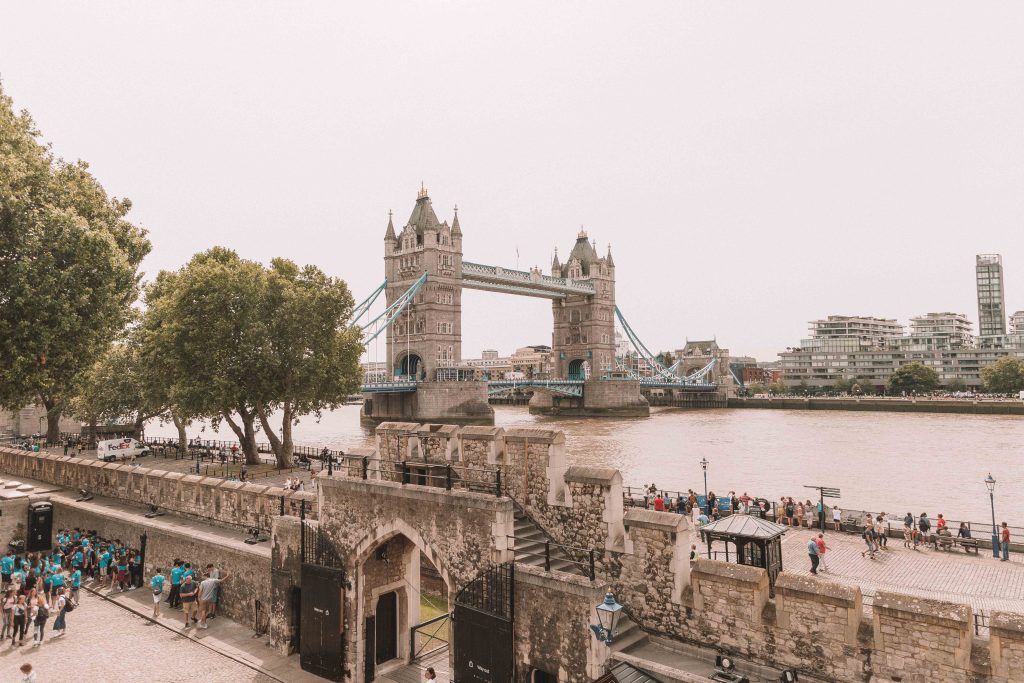
Offering visitors the chance to not only eyeball the Jewels, but to wander former luxurious royal quarters, witness long-kept ceremonial traditions, meet the mystical ravens and get involved with (kid friendly) activities and adventures, the Tower of London demands more than just a quick visit – it’s worth an entire day trip.
Arriving at the Tower of London: The Opening Ceremony
Looking over our itinerary for our day trip to the Tower of London, we noticed that we’d been asked to arrive early: at 8am. As the Tower of London doesn’t open to visitors until 9am, we were more than a little intrigued.
Walking down towards the Tower – London’s skyline already shimmering in the summer heat – we arrived at the entrance right on time; a small crowd of tourists waiting outside. To our right, Tower Bridge glowed in the morning sun and small commuter boats glided silently down the Thames.
It was all very peaceful for central London on a Wednesday morning.
We passed through the entrance of the Tower and through the infamous ‘Traitor’s Gate’. Aside from our small crowd, the Tower was entirely deserted, with just one or two ‘Beefeaters’ passing by. Dressed in their iconic scarlet and gold Tudor regalia, they were busy preparing for the imminent influx of visitors.
Suddenly, a Yeoman Warder appeared in front of us – firmly telling us to stand behind a carefully painted line. ‘You’re about to witness a ceremony that has happened every day for the last nine centuries. Even as bombs fell on London during WW2, this ceremony was still processing’.
Explaining the history behind the Tower’s historic ‘Opening Ceremony’, our Beefeater described how each morning at 9.00am, the Tower’s gates were officially unlocked by the Chief Yeoman Warder, or one of his colleagues.
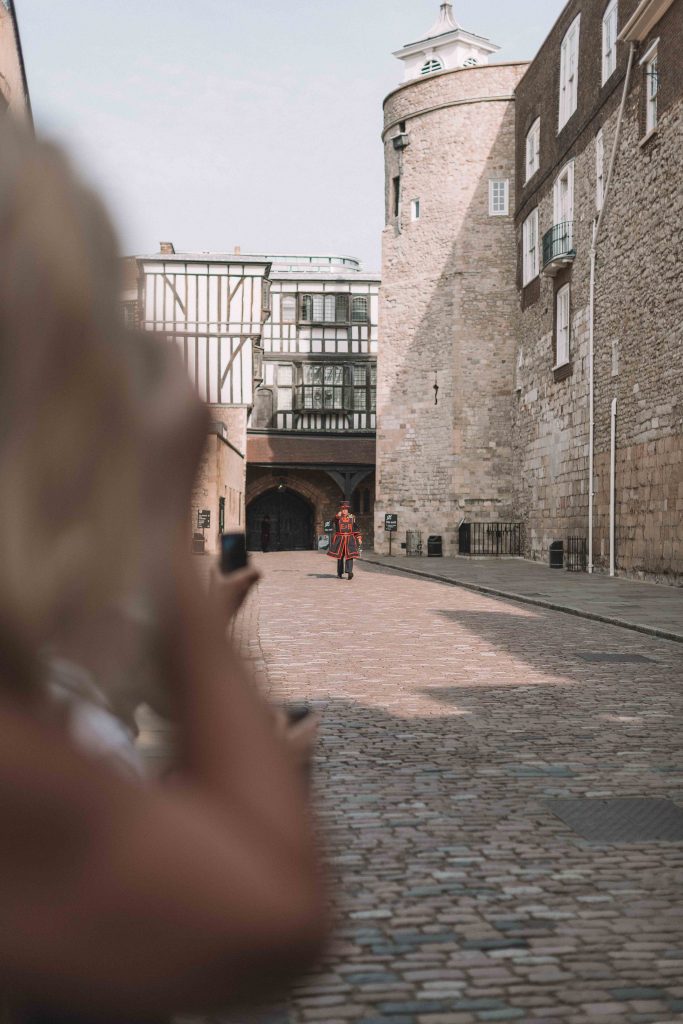
Sure enough, the sound of marching feet rang out across the Tower’s cobbled courtyard; a hint of Bearskin on the horizon. Rounding the corner, the Chief Yeoman Warder and his four Regimental Guards appeared. Clutching an almost novelty-sized loop of keys – the Queen’s Keys, no less – the Warder and Guards marched past us; apparently unaware of our excited whispers.
Of course, unlocking these historical doors is a high stakes business and visitors are (understandably) prevented from getting too close. However, guests can watch from a distance, observing as the Regimental Guards salute and stamp, all before the medieval gate creaks open.
Marching back past us and up through the Bloody Tower from where they came, it seemed that the ceremony was over.
‘This isn’t done for novelty purposes or to attract tourists’, our Yeoman Warder explained as we watched the dark blue and red uniforms disappear up the cobbled hill. ‘Even if it was pouring with rain and there wasn’t a soul here, we would still be performing this ceremony’.
Each night, the Tower is closed in a similarly sacrosanct fashion – as the ‘Ceremony of the Keys’ begins. Commencing at precisely 09.53pm each night, this occasion is said to be the oldest military ceremony in the world. Illuminated by the light of one candle lantern, the Chief Yeoman Warder, flanked by his Guards, locks the Tower for the night whilst declaring he comes to pass over the Queen’s keys.
For those who have a Historic Royal Palaces membership, there are also exclusive member-only ‘Ceremony of the Keys’ evenings. For details on how to book or join the waiting list, please see here.
If you’re not a HRP member, tickets for the ceremony can be secured (for free) here, but sell out very far in advance (tickets for dates from May 2020 – October 2020 will be available on 1 November 2019).
Tickets for the Opening Ceremony can be secured via tour operators such as Get Your Guide and cost approximately £85 (and include early access to the Tower of London and Tower Bridge).
The Tower of London: The Crown Jewels
Slightly hypnotised by the marching Bearskins and Tudor bonnets, we failed to notice that with the Tower’s doors now unlocked, visitors were beginning to flood in.
‘I’d make a beeline for the Crown Jewels now, whilst it’s still quiet’, Sophie – HRP’s Press Officer – whispered. Indeed, at peak times, the Jewel Room can become incredibly crowded, with long queues at its entrance. Even at 9.05am, a fairly impressive line had begun to form.
Housed within the ‘Waterloo Block’, the Crown Jewels are perhaps the Tower of London’s biggest draw. Representing hundreds of years of British royal history, the jewels on show today largely date back to 1660, when Charles II ascended the throne.
Previous to this, the original jewels had been plundered by Oliver Cromwell in 1649, following the execution of Charles I and the resulting ‘interregnum’ period. These precious items (tragically) included Alfred the Great’s State Crown and the 11th Century crown of Queen Edith, wife of Edward the Confessor.
Passing through the Jewel House, our guide, Jenny Tutty, gave a dizzying and succinct history of the British monarchy – with each item on show linked to one of history’s royal heavy weights. From a silver spoon and ‘ampulla’ (likely made for Henry II or Richard I), to a dazzling sapphire, thought to have been taken from the finger of Edward the Confessor, these jewels are more than just a pretty face – they are centuries old historical artefacts.
Perhaps the most impressive sight is the many tiaras and crowns on display – the exhibition’s pièce de résistance. Here, amongst tiny crowns made for Queen Victoria, and a coronation crown so heavy that it gave William IV toothache, you’ll also have the chance to see some of the world’s most famous diamonds.
‘This is the Cullinan (or ‘The First Star of Diamond’) – the largest cut diamond in the world’, Jenny explained as we stared at the star-like gem, perched on top of the Queen’s Sceptre. ‘It is 530 carats’. So big was this diamond, it was originally 3,106 carats, before being painstakingly cut into 9 major stones and 96 smaller ‘brilliants’.
Aside from the Cullinan, visitors are also able to gawp at the world’s most famous diamond: the exotically named ‘Koh-I-Noor’ or ‘Mountain of Light’. Mounted on top of the Queen Mother’s Crown, this gem is 105.6 carats and is said to originate from 14th Century India.
Perhaps understandably, you are prevented from taking photographs of the jewels. However, and despite the cliches, it is a truly brilliant and unforgettable experience. Until you come face-to-face with these treasures – the Black Prince Ruby or the St. Edward’s Sapphire – it’s hard to comprehend just how surreally beautiful they are.
An Unkindness of Ravens
From one treasure to another: it was time to meet the Tower of London’s formidable and mystical ravens.
‘We’re recently trialling talks with the ravens, led by the Yeoman Warders’, Sophie explained as we made our way back into the blinding sunshine. ‘We want people to understand a bit more about our birds and why they’re here’.
Rounding the corner, I heard the ravens (also known as an ‘unkindness of ravens’) before I saw them. A loud, almost prehistoric squawking echoed around the courtyard and a flurry of replies were sent back.
Eventually reaching the raven’s enclosure, we were welcomed by the Tower of London’s Ravenmaster, Chris Skaife. ‘Come in, come in, but watch your toes – Poppy is about’, he warned as we passed through the small gate.
‘You’ve not got flip flops on, have you?’
Although it’s not clear when the ravens first came to the Tower, their extended stay is now the stuff of legends. So perturbed by their insistent presence, Charles II assumed that their residency must be some sort of bird-inspired omen, or at best, a lucky charm. As such, he declared that at least 6 ravens must always be at the Tower, or else the Tower and with it – the Kingdom – would fall.
Since then, ravens have never left the Tower’s side – their large black shapes casting shadows over the leafy gardens.
‘Although traditionally the bird’s flight feathers would have been trimmed to stop them leaving, today they are so domesticated that we don’t need to do that. They are so well fed here, they have no reason to leave’, Chris laughed.
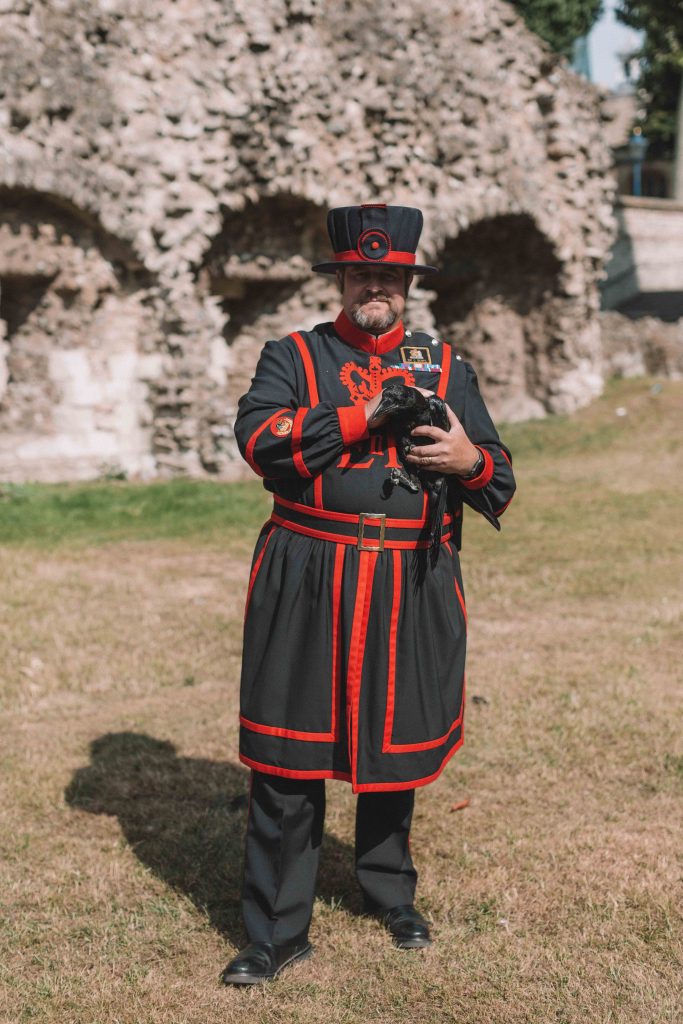
Whilst the ravens have traditionally come to the Tower after being bred (in captivity) elsewhere, the Tower now has a programme dedicated to breeding its own birds. In fact, in April 2019, the Tower celebrated the hatching of four healthy raven chicks – bred in house to proud parents, Huginn and Muninn.
They were the first chicks to be born at the Tower since 1989.
‘The other chicks went to new homes, but George stayed’, Chris explained as he led us to a large pen. ‘She’s imprinted on me so much that she gets a little jealous when I’m with the others’. Opening the door and George – the baby of the Tower – appeared. Cocking her head to one side, she picked up a dry leaf and deposited it in Chris’ hand.
‘Thank you George, that’s very kind’, he replied.
With the intelligence of a seven year old child, ravens are brilliantly clever, curious and ingenious animals. Alongside ensuring the Tower remains standing, the birds are also part of a research project – welcoming teams who are interested in their capabilities. Watching as George picked up tools and eyeballed a nearby Xylophone, it was clear that these birds were frighteningly smart.
If you want to learn more, then the Tower of London’s newly launched Yeoman Warder Raven Talks provide the perfect opportunity to meet the birds. Hosted by the Yeoman Warders, the talks are currently running until November 2019 and will take place daily, beginning at both 11am and 1.30pm and lasting for 15 minutes.
Secrets of the Tower: An Exclusive Private Tour with the Chief Yeoman Warder
Leaving the birds and their loyal Warder behind, we were introduced to Chief Yeoman Warder, Pete McGowran.
Not only would Pete be giving us an exclusive behind-the-scenes tour of the Tower of London, but he would also be providing us with a taste of life as a Yeoman Warder.
Who Are the Yeoman Warders?
The Yeoman Warders were first introduced to the Tower in the 14th Century, and were originally responsible for guarding its prisoners. Over time, this role has naturally changed, and the Warders now play a largely ceremonial role. Responsible for carrying out the opening and closing ceremonies, guiding the public and providing informative tours, the Yeoman Warders remain an inherent and important part of life at the Tower.
‘To be able to be a Yeoman Warder, you’re required to have served a minimum of 22 years in the Forces, serving as either a Warrant Officer or Senior Non Commissioned Officer’, Pete explains as we make our way through the crowds.
Guiding us effortlessly through the Tower’s serpentine lanes, he continues to describe his time at the Tower, all whilst simultaneously greeting guests, posing for photographs and providing directions.
‘It was my wife who said I should apply for a role here’, Pete laughs, ‘before that I was living in Spain. But ten years on and here I am!’
As a prerequisite, all serving Yeoman Warders must live onsite; moving their families into the Tower’s surrounding 13th and 14th Century homes. Today, 37 Yeoman Warders serve the Tower, living what appears to be an idyllic life in this ready made community. With a local pub (‘The Keys’), a resident doctor and a Chaplain, the families are free to roam the Tower’s (unlocked) areas once the site closes for the night.
‘As soon as the public leave, you’ll see the kids come out on their bikes and scooters’, Pete explains. Looking around at this small, historical village, I couldn’t think of a more beautiful place to grow up.
The Tour
The first stop on our behind-the-scenes tour took us to the Yeoman Warder’s Club. Hidden under one of the Tower’s many arches, visitors to the Club must be invited; so exclusive is this inner sanctum.
Ducking through the doorway, we entered a circular room filled with regalia, paintings and a stack of newspapers. In the background, a kettle whistled and several Yeoman Warders busied themselves at a computer or with the morning’s crossword. In the corner, a wood burner stood ready for the colder months.
Dressed in their scarlet and dark blue uniforms, it was a slightly surreal sight to see these iconic London characters brew themselves a tea, but one that was also unexpectedly comforting.
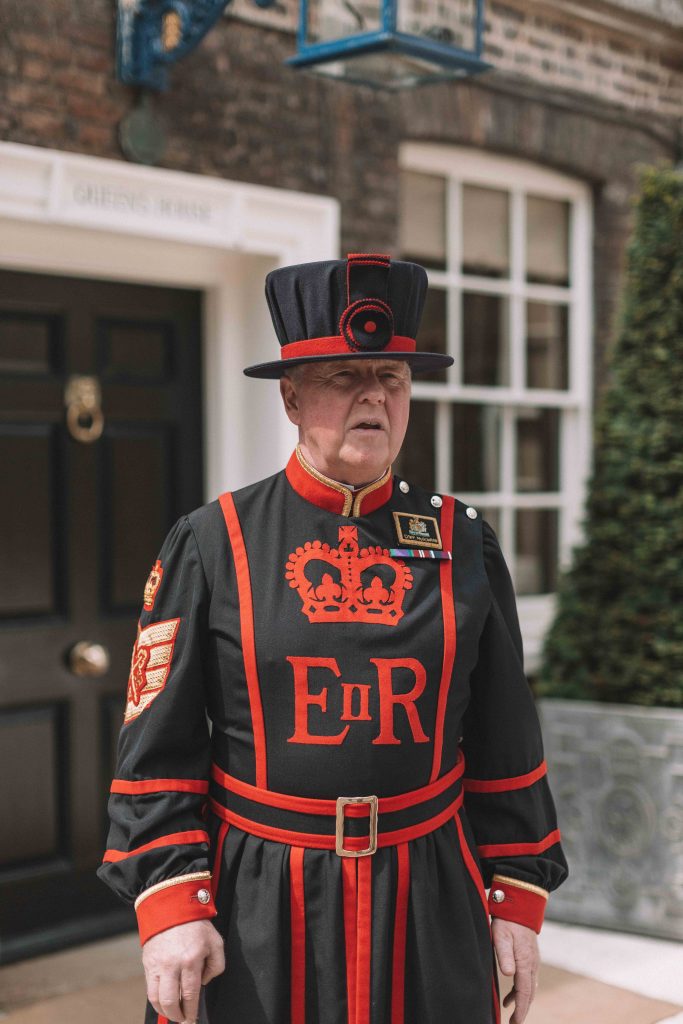
Pointing up to the wall, Pete directed us to a large board bearing the names of every Yeoman Warder to have ever served at the Tower. It was (expectedly) dizzyingly long, and framed next to graffiti from former prisoners and inmates.
Circling back out and up another flight of stairs, we appeared on one of the Tower’s many balconies – affording us the most incredible views across Tower Bridge and the Shard.
Walking along the narrow path, Pete explained that it was here that Queen Elizabeth would ‘take’ her exercise during her time as a prisoner at the Tower. Imprisoned by her half sister, Mary I, Elizabeth spent an agonising two months here, waiting to hear of her fate.
‘And for the finale, I want to show you a cell that was never used – although it was prepared with one particular guest in mind’.
Leading us down a narrow corridor, we arrived at our final destination – a toilet.
‘This toilet was plumbed in for Hitler to use’, Pete declared as we surrounded the sparkling porcelain. ‘Of course, as he was never captured, he never came here – but it was all ready for him’.
Looking around at what might have been Hitler’s final lodgings, it was surreal to think just how many historical characters have been in some way connected with this 11th Century strong hold. From Anne Boleyn to the Kray twins, Guy Fawkes to Lady Jane Grey, the Tower of London was – and continues to be – perhaps one of the most fascinating artefacts our country has to offer.
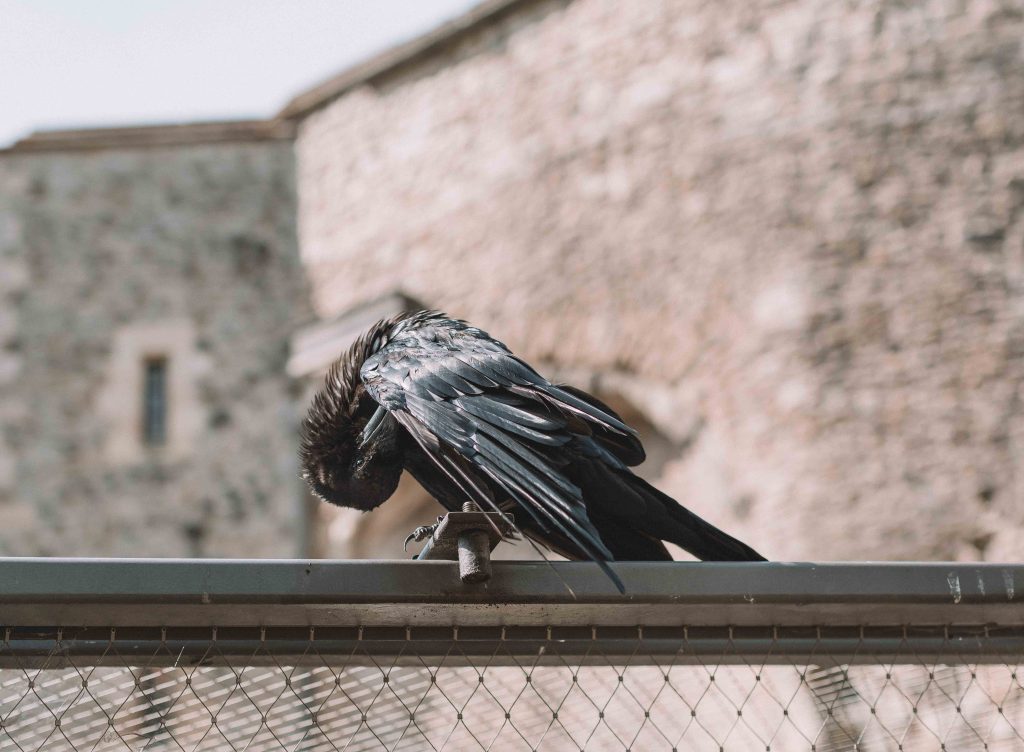
If you wish to book your own one-to-one and exclusive backstage tour of the Tower of London, guides are available from 11-12pm on Tuesdays, Wednesday and Thursdays only. Prices begin at £1,200 and this covers up to 10 guests (£120 pp).
Free Tours with the Yeoman Warders
Of course, for those visiting the Tower of London on a budget, there are also plenty of free tours available, departing every 30 minutes. 45 minutes long, these brilliant and informative sessions are run by the Yeoman Warders and provide guests with an informative insight into the Tower and its history.
Summer Holiday Activities at the Tower of London
With our time at the Tower of London coming to an end, we had just enough time to meet with the Tower’s resident events team. Having spent months planning a dazzling programme of summer adventures, they were keen to share with us news of their latest attraction: ‘Tower Escape’.
Running from 13 July – 31 August, families and children are invited to meet some of the Tower’s most notorious prisoners and escapees. An immersive experience, visitors can follow historical actors along a trail littered with clues, all geared towards helping them plan their escape.
The event culminates with a real life escape, as a number of live performances take place. Including a re-enactment of when prisoner, John Gerard, attempted to escape the tower by abseiling his way down in 1597, this is a fantastic way for families and children to get involved with the history of the Tower.
The experience is included in the cost of your entry ticket (and free to Historic Royal Palaces members).
A Day Trip to the Tower of London: Final Thoughts
The Tower of London is a place that I’ve often passed on my way through the city, but rarely considered visiting. Assuming it’s the sort of historical site aimed at school children or international visitors, I hadn’t given much thought to exploring its historical walls.
However, having enjoyed a day trip to the Tower of London – observing its strict traditions, meeting its resident ravens, viewing its ancient jewels and exploring its hidden rooms – I realise that I’d wrongly judged the Tower. Not simply a lone turret, but an entire village filled with stories, history and some of the most dazzling historical artefacts you’ll have the pleasure of glimpsing, a day trip to the Tower of London is an unforgettable experience.
From polar bears to rolling heads, wayward kings to German spies, the Tower of London – one of the city’s oldest historical structures – is a place that we should all take the time to visit.
Our day trip to the Tower of London was kindly sponsored by Historic Royal Palaces. To find out more about how you can get your own HRP membership, please see here.
Read about our other Historic Royal Palaces adventures:
Pin it: A Day Trip to the Tower of London
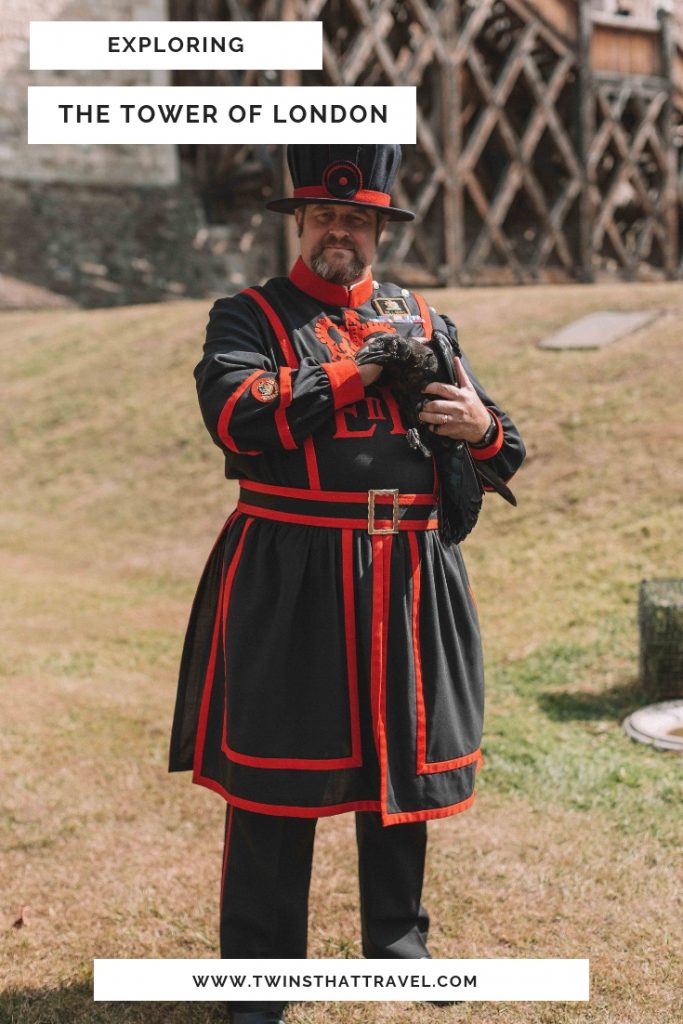



























5 comments
Oh I loved reading this! The Tower of London, and Tower Bridge, have long been my favourite London landmarks. Being from the East side of London, when we get the tube into Tower Hill it is the first thing we see, so from a small child it has been the most familiar sight to me. I have been in the Tower, but not seen the ceremony of the keys or the crown jewels. I must rectify this!
Love that you’re an east-ender!
Aw, this makes me this of A-Level history – which I loved cos I am a massive history geek! We had a school trip to Tower but it must have been so interesting to get the exclusive view!
I LOVED A-level history. Hehe, such a geek!
I loved the Tower of London the history there is just amazing. My favorite thing to see was the crown jewels, definitely worth the wait!